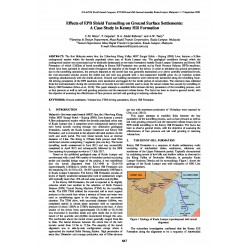Cart
0
0
No document
0,00 €
Total
Document successfully added to your shopping cart
Quantity
Total
There are 0 items in your cart.
There is 1 item in your cart.
Total documents
Total shipping
To be determined
Total
Search & filter
Search for a publication
Search & filter
Effects of EPB Shield Tunnelling on Ground Surface Settlements: A Case Study in Kenny Hill Formation
id225
C. Min Khoo / T. Gopalan / N. 'Afifah Abdul Rahman / A. William Terry
The first Malaysia metro line, the 51km-long Klang Valley MRT Sungai Buloh – Kajang (SBK) Line, features a 9.5km underground section within the densely populated urban area of Kuala Lumpur city. The geological conditions through which the underground section was constructed can be distinctly demarcated as two main formations namely Kuala Lumpur Limestone and Kenny Hill Formation, of which 5.262km of bored tunnelling in Kenny Hill Formation was carried out by Earth Pressure Balance (EPB) machines, which have been operated in closed mode throughout the majority of the length of the drives. In order to minimise the ground movements due to the tunnelling operations, the pressure imparted to the tunnel face was generally maintained at or above carefully predefined levels, the over-excavated annulus around the shield and tail void was grouted with a two-component backfill grout via an injection system operating simultaneously with the shield advance. Ground and building movements were extensively monitored along the tunnelling route. All driving parameters of the EPB machines were monitored and logged for the whole period of construction. The extensive data collected from the instrumentation during the construction of tunnels have been recently used to study the actual volume loss caused by tunnelling in Kenny Hill Formation (Khoo et al., 2019). This paper attempts to establish links between the key parameters of the tunnelling process, such as face pressure as well as tail void grouting pressures and the measured volume losses. The focus has been to observe general trends, with the objective of assessing the effectiveness of face pressure and tail void grouting in reducing volume loss.




